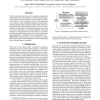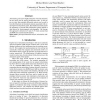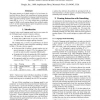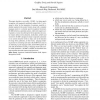118
click to vote
INTERSPEECH
2010
14 years 7 months ago
2010
Using GMM-supervectors as the input to SVM classifiers (namely, GMM-SVM) is one of the promising approaches to text-independent speaker verification. However, one unaddressed issu...
108
Voted
INTERSPEECH
2010
14 years 7 months ago
2010
Over the years, the focus in noise robust speech recognition has shifted from noise robust features to model based techniques such as parallel model combination and uncertainty de...
76
Voted
INTERSPEECH
2010
14 years 7 months ago
2010
Articulatory goals can be highly indicative of lexical intentions, but are rarely used in speech classification tasks. In this paper we show that principal differential analysis c...
99
Voted
INTERSPEECH
2010
14 years 7 months ago
2010
A fast speech extraction (FSE) method is presented using convex optimization made possible by pause detection of the speech sources. Sparse unmixing filters are sought by l1 regul...
105
Voted
INTERSPEECH
2010
14 years 7 months ago
2010
In the paper we present two techniques improving the recognition accuracy of multilayer perceptron neural networks (MLP ANN) by means of adopting Speaker Adaptive Training. The us...
84
Voted
INTERSPEECH
2010
14 years 7 months ago
2010
We follow up on our research demonstrating that aerotactile information can enhance or interfere with accurate auditory perception, even among uninformed and untrained perceivers ...
86
Voted
INTERSPEECH
2010
14 years 7 months ago
2010
The paper presents an in-depth analysis of a less known interaction between Kneser-Ney smoothing and entropy pruning that leads to severe degradation in language model performance...
106
Voted
INTERSPEECH
2010
14 years 7 months ago
2010
We present an investigation of the relevance of simple conversational features as indicators of topic shifts in small-group meetings. Three proposals for representation of dialogu...
103
click to vote
INTERSPEECH
2010
14 years 7 months ago
2010
This paper describes a new toolkit - SCARF - for doing speech recognition with segmental conditional random fields. It is designed to allow for the integration of numerous, possib...
INTERSPEECH
2010
14 years 7 months ago
2010
Multi-pitch estimation of co-channel speech is especially challenging when the underlying pitch tracks are close in pitch value (e.g., when pitch tracks cross). Building on our pr...




